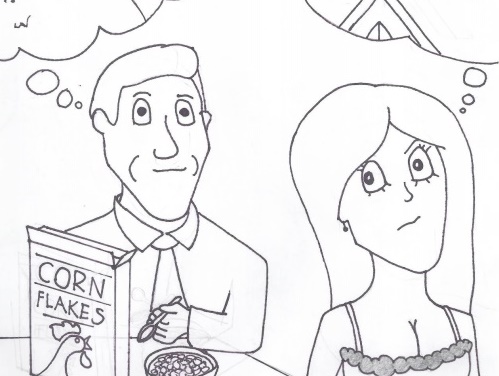Does a big bowl of corn flakes significantly diminish your sex drive? Anti-masturbationist John Harvey Kellogg intended for his breakfast cereal to do so, but your morning wood should remain.
If the notion of touching oneself is still not fully accepted today, during the 19th and 18th centuries, masturbation was thought to be inherently evil.
In 1890, soon-to-be-corn-flake-creator Kellogg published “Plain Facts for Old and Young: Embracing the Natural History and Hygiene of Organic Life.” Within this 652-page diatribe, he cataloged different maladies a masturbator experiences, including general infirmity, mood swings, fickleness, bashfulness, boldness, bad posture, stiff joints, fondness for spicy foods, acne, palpitations, epilepsy, and inability to study.
Fear not, Academic Success tutors; there’s no need to prescribe students struggling with concentration skills a bowl just yet.
For, in Kellogg’s delusional mind, man commits crime, sin, and “unconsidered murders” when indulging in sex of any kind. Masturbation was no exception. Even the Oneida community’s practice of male continence, or intercourse sans ejaculation, was considered “nothing better than double masturbation.”
Kellogg went as far to say men and women have no moral right to indulge in any sexual transgressions because such activity will injure our physical bodies and thus shorten human life. And, while all parties involved are to suffer—the husband, wife, and offspring—Kellogg said, “the husband is the one to whom the sin almost exclusively belongs.”
He wrote that the problem lied in men acting on beastly desires, for “…among the better class of refined and cultivated ladies, the sexual passions are comparatively dormant.” And if women, by chance, want the sex, Kellogg attributed women’s sex drive to bad diet—spicy foods, late suppers, and confectionery.
According to the aforementioned medical literature, cures for younger children included the bandaging or caging of sex organs, the tying of hands, and circumcision administered without anesthetics. For adults (and college students), Kellogg proposed stronger methods of treatment. He suggested threading silver sutures through the foreskin to prevent erection. For women, he thought it a good idea to pour pure carbolic acid on the clitoris to deter them from touching themselves or indulging in mental masturbation.
Yet, ultimately, Kellogg believed the individual is solely responsible for purging his or her mind of evil vices. He asked individuals to avoid solitude and follow strict platonic regimens and healthy diets.
Adhering to his own “Plain Facts,” Kellogg invented three plain foods to curb men and women’s sex drive. A self-proclaimed dietary reformer, he first created granola, a snack consisting of oatmeal and cornmeal baked into biscuits and ground into tiny granules. Yogurt enemas then followed, where machines flushed subjects’ bowels with water and a half a pint of yogurt.
Que the corn flakes.
After Kellogg invented the flaked grain breakfast cereal, he partnered with his brother Will to sell his product to the sinning masses. However, brother Will proved to carry more business sense. He refused to market such a bland, sugarless cereal.
So, when given the option between Kellogg’s Corn Flakes or Frosted Flakes, feel free to spoon either option. Today’s corn flakes cater to both masturbators and non-masturbators alike, causing, we can only suppose, Kellogg to roll his buried bones.
While today readers might laugh at such a creation story, Columbus church-goers took Kellogg seriously.
In 1954, The Miami Daily News published a sidebar titled “Corn Flakes No Longer Sing The Blues,” reporting it was now legal to sell corn flakes in Columbus on Sundays again after the standing mayor uplifted a 1853 grocery ordinance.
Asked if he was familiar with corn flakes’s origins, first-year Nick Fields said he had no idea.
“It’s funny [that] he was against making babies or anything, like sex, that gives us pleasure,” said Fields. “Well, I’m never buying Kellogg’s cereal again.”


